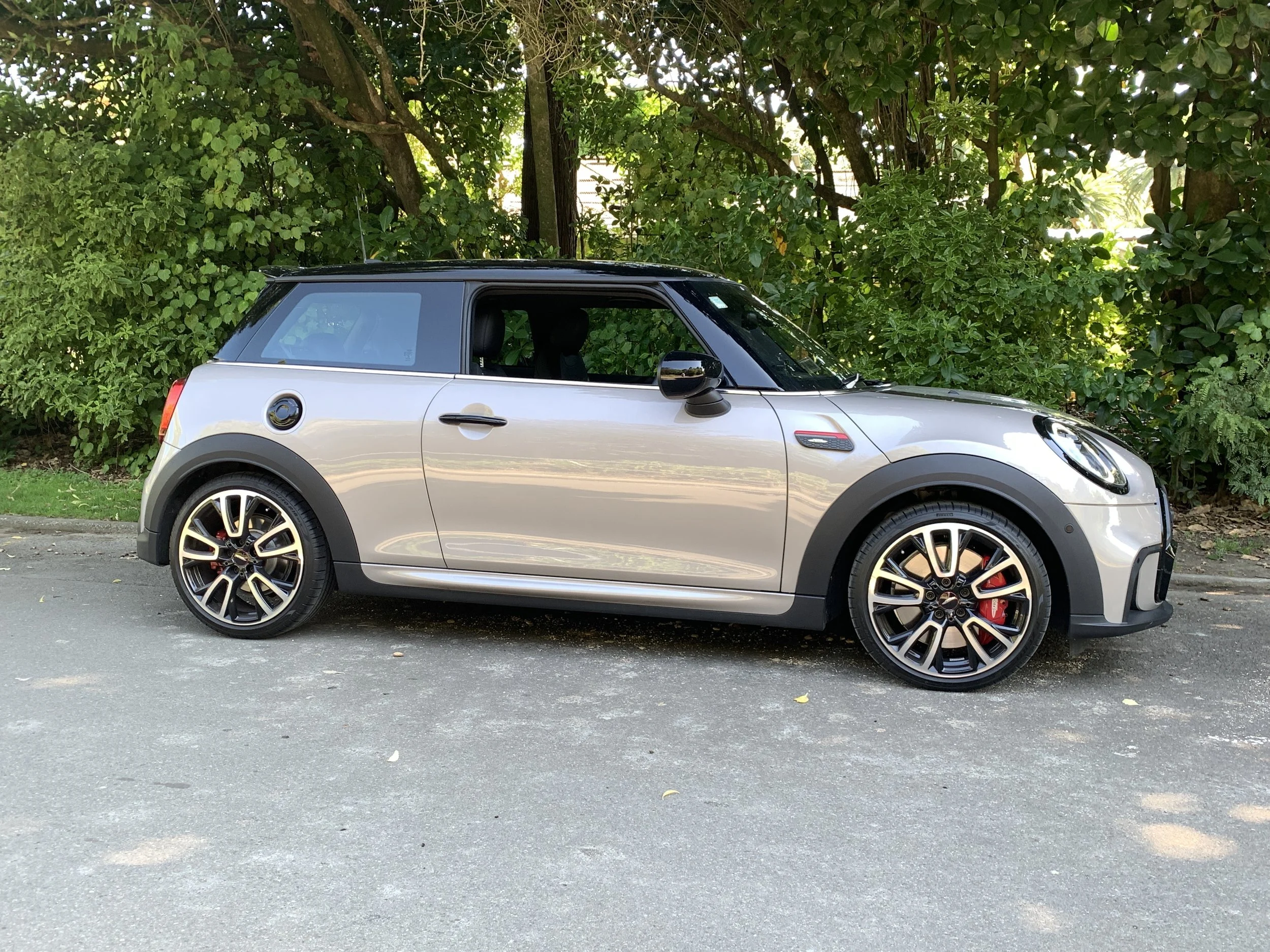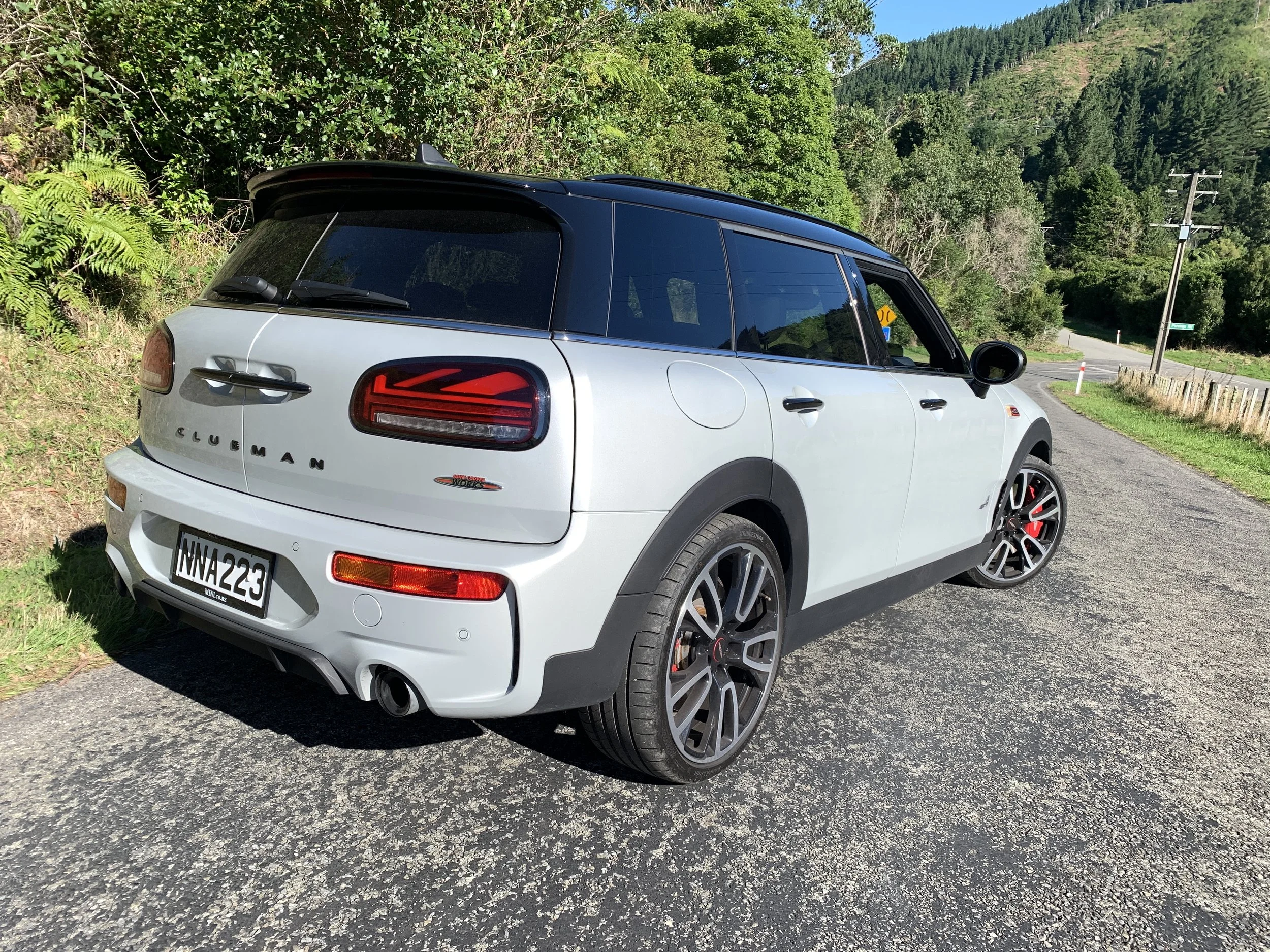MINI JCW hatch and Clubman roadtest review: Big on the small
/These cheeky three and five-door JCW editions are probably perfect for grown-ups who don't want to.
Prices: $66,300/$79,650
Powertrain and economy: 2.0-litre turbo-petrol four-cylinder, 170kW/320Nm (hatch), 225kW/450Nm (Clubman), eight-speed automatic, FWD/AWD, combined economy 6.3 and 7.6 L/100km, CO2 and 143/177g/km.
Vital statistics: Hatch 3863mm long, 1414mm high, 1727mm wide, 2495mm wheelbase, luggage capacity 211 litres, 18-inch wheels. Clubman: 4253mm long, 1441mm high, 1800mm wide, 2670mm wheelbase, luggage capacity 360 litres, 19-inch alloy wheels.
Like: Cheeky character, punchy powertrains, well-sorted dynamics.
Don't like: Hatch’s firm ride becomes wearying, a bit too premium priced.
CAN you imagine a world in which all MINIs adopt electric assisted drivetrains and the biggest one becomes even larger?
That’s next year’s news.
In the here and now, the latest JCW – for John Cooper Works, naturlich – editions, tested today in the hatch and Clubman formats that capture most consumer interest, are the last of the current breed.
With these it’s all about keeping what’s still available fresh until some properly new stuff becomes available.
There’s not long to wait, really. New versions of each are releasing internationally next year and we already know quite a bit.
For instance, the Countryman that is already quite substantial for a brand whose very name suggests quite the opposite is going to upsize yet again, to the point where it will basically move up a segment.
There are good reasons for the line’s second-strongest seller to upsize. One is that it has to adopt BMW’s swanky new FAAR electric architecture that in addition to delivering a fully battery-dedicated drivetrain will also support 48-volt hybrid tech. The current car, of course, has neither.
Also, the dimensional lift gives MINI … actually, let’s depart from the trite marketing spin and call it ‘Mini’ from now on … room for another vehicle in the ‘premium compact’ segment. Thought is that’ll be a space-maximising MPV, taking inspiration from the outrageous Urbanaut concept.
The new design ethos for all incoming Mini cars will, quite fittingly, first be shown by the next three-door hatch. Images leaked from China – because that’s where it will be built - already point to an evolution of the brand’s grille and a new rear facia featuring trapezoidal tail-lights.
All that’s ahead. For now, there’s a last blast refresh of the third-generation Mini, launched back in 2014.
These models were given a design update two years ago, when they gained those Union flag rear lights and other sundry revisions; what’s happened now is a further tweak. Given that the car barely changes aesthetically, you might be wondering why the marque would bother, but they have.
Nothing changes when measured against the stopwatch – where it cuts more of a dash is in the look, but don’t consider that to be a disappointment.
Outputs from the 2.0-litre turbocharged four-cylinder engine common to both, but in different states of tune, remains unaltered. It produces a very respectable 170kW and 320Nm in the hatch, driving the front wheels via an eight-speed torque-converter auto.
The smaller model will smack out 0-100kmh in 6.1 seconds. The Clubman’s tuning raises those outputs another 55kW and 130Nm, which would be too much for front-drive but works out fine here, because now it traversing to terra firma via an all-wheel-drive system. IT gets to 100kmh one second faster, but top speed is much the same.
As much as the refresh stands as being an easy ride for the engine tuners, it’s certainly kept the styling department plenty busy, though there’s a fair bit of subtlety in how the changes render. The latest model identifies across the board by having a larger, reshaped hexagonal grille at the front. With the JCW cars this is in matt black and contrasted by a red stripe.
Body-coloured air ducts sit below the grille on either side of the number plate mounting point, feeding cool air into the braking system. Another set of angular air openings cool the powertrain.
There are minor detail changes at the back, too, such as a slim LED foglamp. Sitting square in the middle of the new diffuser is a set of 85-millimetre stainless steel sports tailpipes with a contrasting chrome finish. Also inbound are new colours and wheel designs.
Mini has redesigned the Brembo-provisioned brakes. The four-piston front calipers are also painted red and adorned with the John Cooper Works logo.
Inside, an 8.8-inch touch-reactive infotainment screen arrives and infotainment software has also been updated, benefiting from a revised display and controller that together more closely related to BMW’s iDrive and by and large make interfacing with the audio, navigation, communication and app systems more intuitive.
There’s been some minor tidying up of the switchgear and air vents, and everything is, of course, highly stylised; it wouldn’t be a Mini without plenty of toggle switches, not just ahead but also overhead.
As much as this approach layers into the car’s sense of occasion, even those fully immersed into the ‘vibe’ would surely still agree the liberal application of so many showy touches has potential to irk or confuse, particularly for first-timers.
Regardless that it’s operability is up to speed, the touchscreen not being the largest makes it a bit hit and miss when on the move. Also, it seems a bit odd to have a rectangular display within a round area. If you don’t already have an Apple communication device, best get one: This car is utterly sorted for Car Play. It’ll cope anything other, but only with reluctance, as we discovered when my wife sought to link up her Android Auto-related device. Even iPhone users have to make concession to Mini’s achingly pure design requirements; you’ll find a standard-sized phone will only fit properly into the beautifully-design recharging tray, underneath the centre armrest, after it’s been removed from any kind of protective cover.
The JCW also comes with a host of safety features as standard that include adaptive cruise control with stop and go functionality and parking assist.
A bespoke chassis tune for the suspension comes as standard for the JCW, and as an optional extra, buyers can tick Mini’s Adaptive Suspension box.
These electronically controlled dampers make adjustments to suit the road conditions in just 50-100 milliseconds, for a more dynamic ride. There are a number of different modes that can be selected depending on the driver’s mood, which includes ‘Lounge’ and ‘Sport’ mode. In other works, hit the switch to achieve various degrees of joltiness.
Still, all part of the ethos, right?
John Cooper Minis were true standouts during the 1960s’ and the influence the late great Briton’s F1 championship-winning touch had on these cheeky cars is recognised now by these models.
The hatch is probably more authentically relevant, insofar that back in Cooper’s day, it was the only focus for hotting up. The only presumable motorsport use for a Mini van – which is what the Clubman kinda is, if only because it has those barn-style rear doors - would have involved parts delivery.
Today’s Clubman has morphed into a totally upmarket and very plush model now, more than several social classes above the 1960s’ muse. It’s a decent-sized five-seater car, with good boot space.
And then some. Though it is not really a hot hatch in its styling, it is certainly very much one in intent, with enough oomph to go toe-to-toe with the similarly-priced Mercedes-AMG A35 and Audi S3. Not bad for a model that might almost pass as a boutique bakery’s delivery van.
The hatch is quite a bit bonkers, too. More than it potentially should be, given an eight-speed auto involves. Yet the Sport mode is emphatically that; the gearchanges hold much longer and become snappier at much higher revs and in either state of tune the engine sounds rorty, with pukka snap-crackle-pop emotion.
With the hatch everything downloads thorough the front wheels. The Clubman, on the other hand, has an on-demand AWD, which has a mechanical diff lock to help traction up front and minimise torque steer, also alters its feed in that optimal fun setting, sending more to the rear.
JCW cars have a stiffer body structure and are lower. This, plus with geometry alteration for faster cornering and more dextrous hard-driving handling, means you get rather a lot of firmness for general driving. But that’s JCW typical. Likewise, the beefed up brakes that can seem a little snatchy and meaty low profile tyres are of a type that’ll likely be worn down by coarse chip regularity.
In either, there’s such massive front-end grip you feel inspired to be quite brave in entering corners, though ultimately it’s the AWD model in which you have stronger sense of it being a faithful apex magnet. The steering is awesome, with excellent weighting and good feel and feedback. In either, there’s a level of competence that a driver of an original Mini Cooper simply wouldn't believe possible.
The reason for the Clubman’s parking space-filling design becomes evident when you’re the cabin. It’s the rarest of Minis in being almost maxi. Rear seat room is generous enough to make it appealing to someone of my above-average height. When dropping down that back seat, too, the boot becomes very commodious. You cannot say the same with the hatch. It’s not a shoebox, but neither does it deliver the family car appeal of the larger offer.
As much as people might still like to sneer at BMW’s Mini even after all these years, there’s no doubt Munich has done a great job with this revival. Bear in mind that the ‘German’ Mini has been much more successful commercially than BMC’s original ever managed.
























